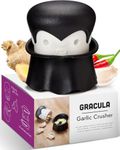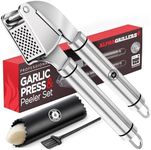Buying Guide for the Best Garlic Presses
Choosing the right garlic press can make food preparation much easier and more enjoyable, especially if you use garlic often in your cooking. A good garlic press should be comfortable to use, easy to clean, and effective at crushing garlic cloves with minimal effort. When shopping for a garlic press, it's important to consider how often you'll use it, how much garlic you typically prepare at once, and how much effort you want to put into cleaning up afterward. Understanding the key features will help you find a garlic press that fits your kitchen habits and makes your cooking more efficient.MaterialThe material of a garlic press affects its durability, ease of cleaning, and how comfortable it is to use. Common materials include stainless steel, aluminum, and plastic. Stainless steel is the most durable and resistant to rust, making it a good choice for frequent use and easy cleaning, even in the dishwasher. Aluminum presses are lighter and often less expensive, but they may not last as long and can sometimes react with acidic foods. Plastic presses are lightweight and affordable, but they may not be as strong or long-lasting. If you plan to use your garlic press regularly, stainless steel is usually the best option, while occasional users might be satisfied with aluminum or plastic.
Handle DesignThe design of the handles determines how comfortable and easy the garlic press is to use, especially if you have limited hand strength. Handles can be straight or ergonomically shaped, and may have padding or grips for added comfort. Longer handles provide more leverage, making it easier to press garlic with less effort, while shorter handles may require more force. If you often prepare large amounts of garlic or have weaker hands, look for a press with ergonomic, cushioned, or longer handles. For occasional or small-scale use, a basic handle design may be sufficient.
Chamber SizeThe chamber is where you place the garlic cloves, and its size determines how much garlic you can press at once. Larger chambers allow you to crush multiple cloves at a time, which is convenient for recipes that call for a lot of garlic. Smaller chambers are fine for single cloves and may be easier to clean. If you frequently cook for a family or enjoy garlic-heavy dishes, a larger chamber will save you time. For occasional use or single servings, a smaller chamber is usually adequate.
Ease of CleaningCleaning a garlic press can be tricky, as garlic tends to get stuck in small holes. Some presses are dishwasher safe, while others need to be washed by hand. Features like removable chambers or built-in cleaning tools can make the process much easier. If you dislike scrubbing or want to save time, look for a press that is dishwasher safe or has parts that come apart for thorough cleaning. If you don't mind a bit of extra effort, a simpler design may work for you.
Pressing MechanismThe pressing mechanism refers to how the garlic is crushed—some presses use a simple lever action, while others have a rocking or twisting motion. Lever-style presses are the most common and are generally easy to use, but may require more force. Rocking presses are pressed down and rocked back and forth, which can be easier on the hands and allow for more control. If you have limited hand strength or want a gentler pressing action, consider a rocking or ergonomic mechanism. For straightforward, quick pressing, a traditional lever style is usually sufficient.















